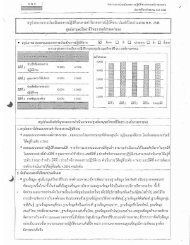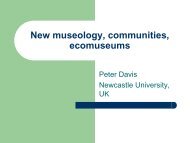Download
Download
Download
You also want an ePaper? Increase the reach of your titles
YUMPU automatically turns print PDFs into web optimized ePapers that Google loves.
In the research “Rights Claims and the Strategic Useof Culture to Protect Human Rights,” I explore suchinteraction. Looking at the rights discourse from a socialconstructionist standpoint, I do not search for a definitemeaning of community rights. Instead, I attempt tounderstand how rights are perceived and claimed andhow culture is used strategically as a resource in suchprocess.In search of rights: Rights claimsbased on legitimacyDuring my field research in two northeasternvillages that participated in the community forestmovement, I set out to identify and better understand thetraditional forest-related practices such as those that wereoften cited by the movement’s supporters as the basisof community rights and legitimacy to live in protectedareas. However, I soon learned that this task was not assimple as I initially expected it to be.One of the most prominent strategic framing processesused by leaders of the community forest movementin Thailand was the reference to communal traditionalknowledge and cultural beliefs and practices which reflecta harmonious, respectful and sustainable relationshipwith the forest. In this strategic discourse, local culturalpractices are reinterpreted within an environmentalistframework to support the villager’s claim for legitimacy.For example, the beliefs and practices surrounding thesacred shrines of the ancestral spirits (pu ta) 2 are oftenexplained in environmental terms, as traditional beliefsthat promote environmental conservation. Some “localtraditional practices” are also formalized and labeled withenvironmental values. The significant case in point is theformalization of communal land/forest use by demarcatingcertain areas as “community forests” (pa chumchon). Thepa chumchon is to be managed according to communityforest management regulations and monitored by acommunity committee.From my discussions with local residents,however, I learned that most villagers were not explicitlyconscious of the environmental implications of the pu ta2 Literally, pu ta means grandfather.A pu ta shrineforest and pa chumchon, with perhaps the exception ofa few community leaders. In the two villages I studied,the villagers rarely used the pa chumchon, and mainlycollected forest products from the protected forestsurrounding the villages. To my surprise, many were notaware of the existence of the pa chumchon in the villageat all. Having witnessed the community forest movement’sstrategic use of culture to assert claims of resourceentitlement on behalf of the community, I became morecritically aware of the need to examine the communityrights discourse from a constructionist perspective.Both of villages where I conducted field researchdiffered markedly from the prevailing image of the “localtraditional community” as represented in Section 46 andSection 66 of the 1997 and 2007 Constitutions respectively.Firstly, the villages were relatively new, having beenestablished by economic migrants in search of agriculturalland during the 1950s and 1960s. Moreover, one of thevillages was linguistically and ethnically diverse, andtherefore that village did not have a shared body oftraditions or homogeneous cultural practices to constitutea unified, collective identity. In both villages, the so-called“cultural practices” related to forest conservation werenewly introduced, mainly to support the struggle to remainliving in the protected forest.







